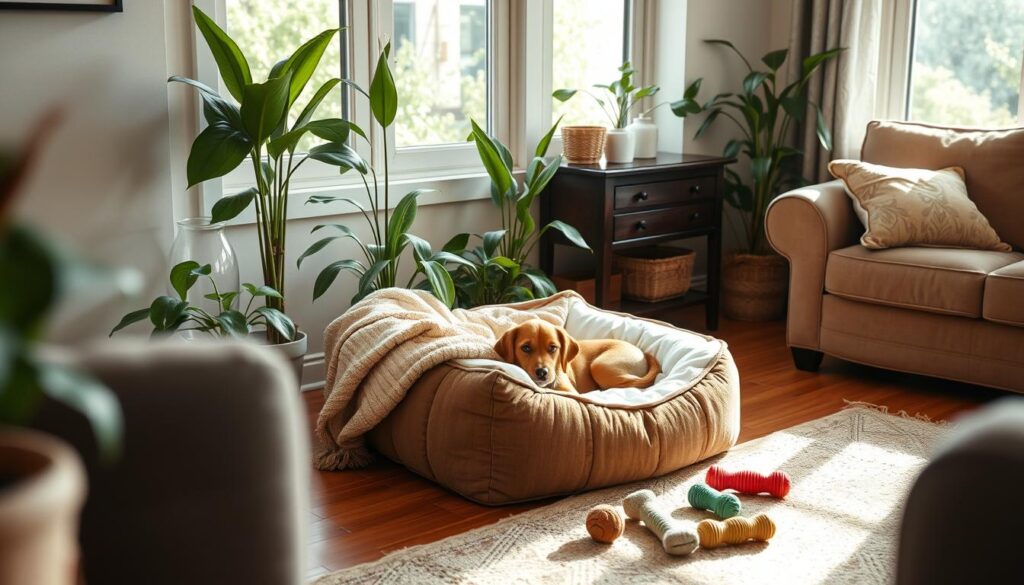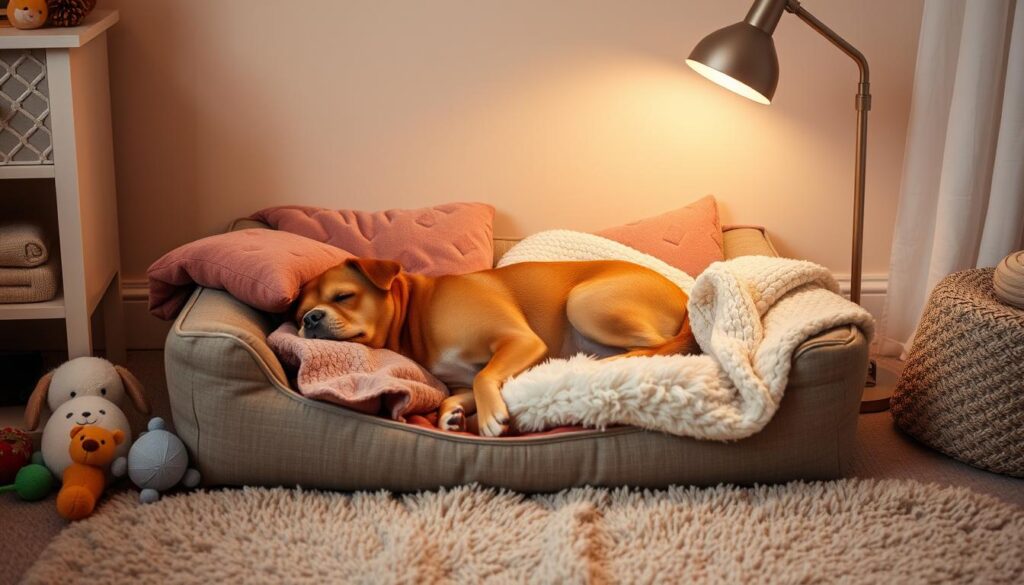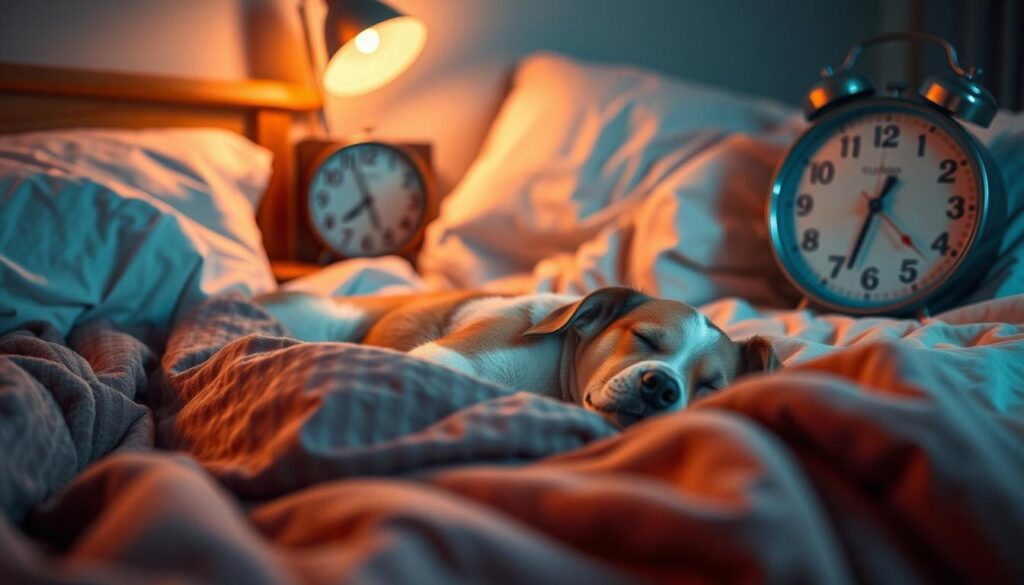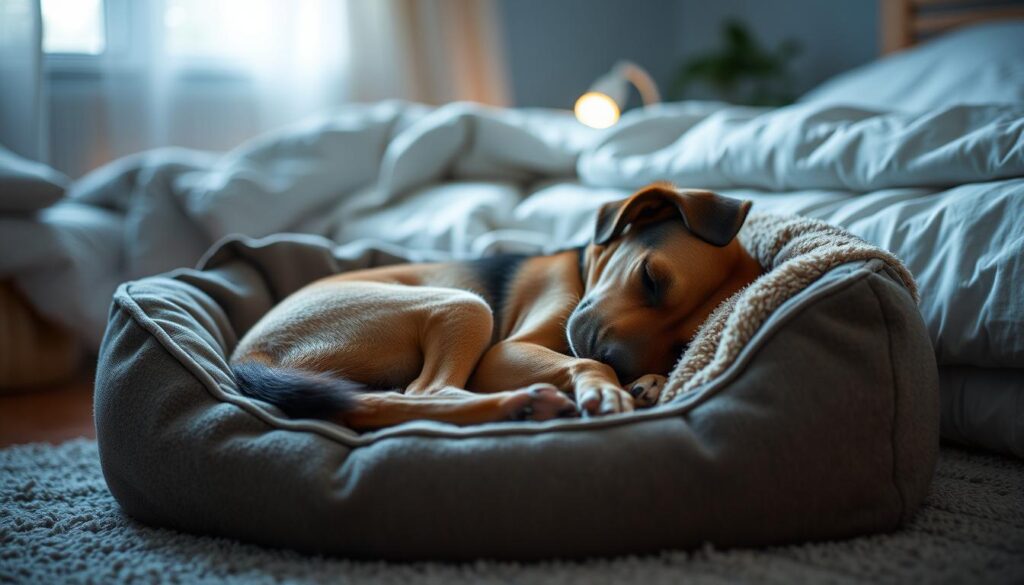Did you know dogs sleep up to 14 hours a day? This shows how important a comfy sleeping spot is for them. As a dog owner, I’ve found that teaching your dog to sleep in their bed can really help. It improves their sleep and yours too. In this guide, I’ll share tips on how to teach your dog to sleep in their bed.
Choosing the right pet bed is critical for good sleep habits. Look for a bed that fits your dog’s size and meets their needs. Some beds even have special features like water-resistant fabric or cooling gel for extra comfort.
Training your dog to sleep in their bed means setting clear rules and routines. Use simple commands like “go to bed” or “bed” to guide them. Treats and praise are great for encouraging your dog during training.
Key Takeaways
- Dogs need up to 14 hours of sleep daily, making a comfortable bed essential
- Choose a pet bed based on your dog’s size and specific needs
- Use simple, consistent commands for effective dog sleep training
- Positive reinforcement encourages desired sleeping behaviors
- Establish a routine to help your dog adapt to their new sleeping arrangement
Understanding the Importance of Proper Sleep Training

Sleep training is important for your dog’s health and your own sleep. Dogs sleep about 16 hours a day, almost double what humans do. This shows how important it is to make their sleep area comfy.
Benefits for Your Dog’s Health
Good sleep training boosts your dog’s health and sleep habits. Dogs sleep in shorter cycles and wake up more often. So, they need more sleep to feel rested.
A regular sleep schedule helps them sleep better and stay healthy.
Impact on Your Sleep Quality
Training your dog to sleep in their own bed can make your sleep better too. It cuts down on nighttime wake-ups. This means you and your dog can both sleep more soundly.
Creating Healthy Boundaries
Having a special sleeping spot for your dog sets clear rules in your home. It helps your dog know their place and can lower anxiety. This is especially true for puppies, helping them grow and trust you more.
| Aspect | Dog | Human |
|---|---|---|
| Daily Sleep Needs | 16 hours | 7-9 hours |
| Sleep Cycle Length | Shorter | Longer |
| Peak Activity Times | Dusk and Dawn | Daytime |
Step-by-Step Training Process

Teaching your dog to sleep in their bed takes patience and consistency. It makes your pup more comfortable and helps you sleep better. Here’s how to introduce and train your dog to sleep in their bed.
Introducing the Bed
Begin by placing the dog bed in a quiet, cozy area. Add a favorite toy or treat to make it inviting. Let your dog explore the bed on their own. Don’t force them onto it. Positive vibes are important in this first step.
Teaching the “Go to Bed” Command
When your dog is okay with the bed, teach them the “go to bed” command. Use a consistent phrase like “go to bed” or “bedtime.” Lead them to the bed, say the command, and reward them. Do this several times a day.
Practice and Repetition
Consistency is critical in dog training. Practice the “go to bed” command at different times. Start with short periods and gradually increase the time before rewarding them. This helps them stay in bed longer.
Nighttime Training
Nighttime training is the last step to a good sleep routine. Add the “go to bed” command to your evening routine. Crate training techniques can also help. Reward your dog for sleeping through the night. If they wake up, guide them back to bed calmly.
Every dog learns at their own pace. Be patient and keep training consistently. Soon, your dog will sleep in their bed happily, giving you both better rest.
Selecting the Perfect Dog Bed

Finding the right dog bed is important to your pet’s comfort and health. The right bed can make a big difference in their sleep and happiness. Let’s look at what to consider when picking the best bed for your furry friend.
Size and Shape Considerations
A bed that fits well is essential for comfort. Measure your dog from nose to tail and add 6-12 inches for length. For width, measure them curled up and add a few inches.
Round or oval beds are great for dogs who curl up. Rectangular beds are better for dogs who stretch out.
Material and Durability Factors
Choose durable, easy-to-clean materials with removable covers. Memory foam and high-density orthopedic foam are great for support. Waterproof liners help protect against accidents.
If your dog likes to chew, look for chew-resistant fabrics.
Special Features for Specific Needs
Orthopedic dog beds are good for pets with joint issues or arthritis. Prices vary from $50 to $300+, with options like the BarksBar Orthopedic Dog Bed ($87) or the Big Barker 7″ Pillow Top Orthopedic Dog Bed ($290).
For warm weather, cooling dog beds with gel-infused foam keep your dog cool.
| Bed Type | Key Features | Price Range |
|---|---|---|
| Standard | Basic cushioning, washable cover | $20-$100 |
| Orthopedic | Memory foam, joint support | $50-$300+ |
| Cooling | Gel-infused foam, breathable fabric | $40-$200 |
Watch how your dog reacts to the new bed. If they use it often and seem happier, you’ve made a great choice. With the right thought, you’ll find the perfect bed for your dog.
Strategic Bed Placement in Your Home

Finding the perfect spot for your dog’s bed is important for their comfort and your peace. Watching where your dog likes to rest helps you decide. Many dogs choose places where they can see family or watch the house.
- Proximity to your bedroom
- Traffic flow in the house
- Temperature and draft-free zones
- Noise levels
For puppies, starting with their bed in your room helps with separation anxiety. As they grow, you can move the bed to its final spot. Remember, being consistent is important. Once you’ve picked the best spot, don’t move the bed to avoid confusion.
A good dog bed spot can really help your pet sleep better and behave well. By making a cozy sleeping area, you help them develop good sleep habits. This method works well with other training, like teaching your dog to fetch and other positive reinforcement techniques.
Essential Commands for Bed Training

Training your dog to sleep in their bed needs consistent use of dog bed commands. Mastering these pet training phrases is crucial for successful canine obedience. We will now look at the basics of bed training commands.
Basic Command Structure
Keep your commands simple and clear. I use short phrases like “go to bed” or “bedtime” for my dog. These straightforward commands are easy for pets to understand and remember.
Choosing Your Command Phrase
Pick a phrase that works for you and stick with it. Consistency is important in pet training. Whether you prefer “to your bed” or “sleep time,” use the same command every time to reinforce the behavior.
Timing and Consistency
Timing is everything in canine obedience. Issue your chosen command when it’s time for bed or during training sessions. Repeat the command consistently to help your dog associate the phrase with the action of going to their bed.
Voice Tone and Hand Signals
Use a firm, clear voice when giving bed commands. I pair my verbal cues with hand signals, pointing to the bed while saying the command. This dual approach reinforces the message and can be especially helpful for dogs who respond well to visual cues.
Remember, patience is critical in pet training. With consistent practice of these dog bed commands, your furry friend will soon master the art of sleeping in their own bed.
Using Positive Reinforcement Techniques

Positive pet reinforcement is critical to good dog training rewards. Treats are great motivators. When your dog goes to bed, give them a treat right away. This links the action to a good feeling.
Verbal praise is also important. Saying “good boy” or “good girl” shows you approve. Add in some physical touch like head pats or ear scratches. Your dog will feel loved and safe when they go to bed.
Being consistent is crucial in dog training rewards. Always reward your dog when they go to bed. This makes them look forward to the reward. Soon, going to bed will be a happy time for them.
- Use treats as primary motivators
- Offer verbal praise and physical affection
- Reward consistently to reinforce behavior
Positive pet reinforcement is more than just treats. It’s about making your dog feel loved and understood. With patience and consistent use of these methods, your dog will happily go to bed when asked.
Daytime training sessions

Daytime pet training is crucial for a dog’s bed practice. I start by adding bed commands to our daily routines. This method works great for German shepherds and golden retrievers.
I teach my dog to go to bed from different rooms and distances. Using the “go to bed” command helps them find their sleeping spot. Food is a big motivator in this training.
I increase how long my dog stays in bed, rewarding them for good behavior. They learn to go to bed without treats every time. This consistency helps them develop new sleep habits.
For dogs I’ve recently adopted, I start training right away. The sooner we begin, the better the results. I also make sure they get enough exercise during the day. This helps with training and ensures they sleep well at night.
Dogs can sleep up to 14 hours a day. By focusing on daytime training, we help them sleep better at night. This leads to peaceful nights and well-rested pets.
Creating a Consistent Bedtime Routine

A well-structured pet bedtime routine is important to improving your dog’s sleep schedule. By establishing consistent patterns, you can help your furry friend wind down and prepare for a restful night.
Pre-bedtime Activities
Start your dog sleep schedule with calming activities. Take a short evening walk to release pent-up energy. This helps your dog relax without overstimulation. Follow up with gentle petting or a quick indoor game like hide-and-seek. These activities signal it’s almost bedtime.
Establishing Time Patterns
Consistency is crucial for an effective pet bedtime routine. Set a regular time for your dog’s last meal, at least three hours before bed. This reduces the chance of late-night bathroom breaks. Dim the lights and play soft music to create a peaceful atmosphere. These cues help regulate your dog’s internal clock, promoting better sleep quality.
Remember to provide a final bathroom break before bed. Use a comfortable pet bed or crate to create a cozy sleep environment. By maintaining these patterns, you’ll help your dog develop healthy sleep habits and improve overall well-being.
Common Challenges During Training

Dog training difficulties and pet sleep problems are common. Many pet owners face these issues. I’ve seen many challenges while training dogs to sleep in their beds. Let’s look at some typical problems and how to solve them.
Dealing with Resistance
Dogs often don’t like new routines. To tackle this, I break training into smaller steps. I start with short 5-repetition sessions of the “go to bed” command. This keeps dogs interested and stops them from getting stuck.
Managing Night Anxiety
Night anxiety can mess up sleep training. I’ve found that slowly increasing distance from the bed helps. I start by stepping back just one foot, then slowly increase it. This method has worked well for many dogs I’ve trained.
Addressing Persistent Behaviors
Some dogs have behaviors that make sleep training hard. In my experience, 30% of dogs might show aggressive behaviors about bed privileges. For these cases, I recommend removing dogs from the bed entirely.
Non-aggressive behaviors like intense snuggling or inappropriate peeing need patience and consistent training. Remember, every dog is different. What works for one might not work for another. Stay patient, consistent, and adjust your approach as needed. If problems last, don’t hesitate to seek professional help.
Making the Bed Appealing to Your Dog

Start by picking a comfortable dog bed that fits your dog’s size and sleep style. Orthopedic beds are great for dogs with joint issues. They help ease stiff joints and offer extra support.
To make the bed more appealing, add your dog’s favorite toys or a familiar blanket. This adds a sense of security and comfort. Place the bed in a quiet spot, away from busy areas, for a peaceful sleep.
It’s important to choose a dog bed that’s easy to clean. Look for beds with removable, machine-washable covers. This keeps the bed fresh and inviting for your pet.
| Tips for an Attractive Pet Sleeping Area | Benefits |
|---|---|
| Add favorite toys | Increases comfort and familiarity |
| Use a familiar blanket | Provides a sense of security |
| Choose a quiet location | Ensures peaceful sleep |
| Select washable bedding | Maintains cleanliness and hygiene |
Positive reinforcement is important in getting your dog to use their new bed. Give treats or gentle praise when they show interest. This helps them associate the bed with positive feelings.
Nighttime Exercise and Activity Requirements

A good dog exercise routine is essential for a restful night’s sleep. Dogs need physical activity and mental stimulation before bed. This helps them relax and settle into their sleep routine.
Pre-bedtime Walk Benefits
A walk before bed is beneficial for several reasons. It helps dogs burn off energy, go to the bathroom, and calm down. Adult dogs sleep 12-18 hours a day, so a walk can help them match your sleep schedule.
Mental Stimulation Activities
Evening mental stimulation is as crucial as physical exercise. Puzzle toys, short training sessions, or games like hide-and-seek can keep your dog’s mind active. These activities prevent boredom and reduce restlessness at night.
Adjust the intensity of your dog’s evening activities based on their age, breed, and energy level. Puppies need more frequent potty breaks at night. For older dogs or those with health issues, gentler activities are better.
By mixing physical exercise with mental stimulation in your dog’s evening routine, you ensure a peaceful night’s sleep. This approach supports basic dog obedience training and keeps your dog well-behaved and content.
Addressing Sleep Disruptions

Dogs can face sleep problems for many reasons. As a pet owner, I’ve learned patience and understanding are key. Nighttime pet behavior can be affected by the environment, health issues, or anxiety.
To solve sleep issues, I first find the cause. This might mean watching my dog’s habits or talking to a vet. Common causes include noise, discomfort, or health problems. Then, I make changes to help my dog sleep better.
It’s important to create a quiet, comfy place for my dog to sleep. I use white noise machines or calming music to block out loud sounds. This helps my dog relax and sleep better. I also make sure the sleeping area is the right temperature and draft-free.
For dogs with anxiety, a regular bedtime routine helps a lot. This could be a calm walk, quiet play, or relaxation exercises. Over time, this routine tells my dog it’s time to sleep.
If sleep problems don’t go away, I look into medical reasons. Issues like arthritis, kidney disease, or cognitive problems can mess with sleep. Working with a vet to fix these problems is critical to better sleep.
By tackling these issues, I’ve helped my dog sleep better. This has improved our rest together.
Special Considerations for Puppies

Puppy sleep training needs patience and understanding. Young dogs have different needs than adult dogs. I’ll share important tips to help you through this important time with your puppy.
Age-specific Training Approaches
Age is important in puppy sleep training. Most puppies sleep through the night by 4 months. But, some might need more time.
Crate training helps puppies learn to sleep alone. It’s best to start early, not later.
Developmental Stages
Knowing your puppy’s growth stages is vital for training. As puppies grow, their behavior changes. Here are sleep milestones to watch:
| Age | Sleep Behavior | Training Focus |
|---|---|---|
| 8-16 weeks | Frequent naps, nighttime wakings | Establish bedtime routine, introduce crate |
| 4-6 months | Sleeping through night, longer wake periods | Reinforce crate training, extend time alone |
| 6-12 months | Adult-like sleep patterns | Transition to dog bed, maintain consistency |
Every puppy is different. Tailor your training to fit your dog’s needs. Being consistent is crucial in training a dog from a young age. With patience and positive reinforcement, your puppy will learn to sleep well for life.
Training Multiple Dogs

Training multiple dogs in multi-dog households requires a smart plan. I’ve learned that giving each dog their own training time is essential. This way, they can learn commands without being distracted by their siblings.
Short training sessions of 5-10 minutes for each dog work well. This keeps them focused and stops them from getting bored. I use special words for each dog to avoid confusion and make it clear when it’s their turn.
Station training is great for homes with many dogs. I teach each dog to wait in a specific spot. This helps them learn patience and self-control. As time goes on, I reduce the rewards for waiting, helping them stay calm while I train others.
| Training Technique | Benefits |
|---|---|
| Individual Sessions | Focused attention, fewer distractions |
| Short Sessions | Maintains engagement, prevents boredom |
| Unique Release Words | Avoids confusion, clear communication |
| Station Training | Teaches patience, promotes self-control |
Consistency is important in training multiple dogs. Each dog should have their own food bowl and eating area. Measuring food and keeping regular feeding times helps keep things orderly and prevents fights over food.
Maintaining Long-term Sleep Habits

Keeping your dog’s sleep habits in check requires effort. It’s important to stick to good habits. As your dog ages or your home changes, you might need to adjust their routine.
Consistency Methods
Consistency is key. I ensure my dog’s bedtime is always the same. This helps them learn to sleep in their own bed. A brisk walk before bed also helps them sleep better.
Dealing with Setbacks
Setbacks are part of the journey. If my dog tries to sleep in my bed, I go back to basics. I use positive reinforcement and gentle guidance to remind them of their own bed. Being patient is crucial during these times.
Adult dogs need 12-14 hours of sleep each day. Older dogs and puppies might need up to 20 hours. It’s important for their health and your sleep to ensure they rest in their own bed.
| Age Group | Required Sleep (hours) |
|---|---|
| Adult Dogs | 12-14 |
| Puppies and Older Dogs | 18-20 |
By keeping sleep habits consistent, you’re helping your dog sleep well for life. This benefits both you and your furry friend.
When to Seek Professional Help
Sometimes, dog sleep training can be tough. My Cardigan Corgi had trouble stopping his late-night cat-chasing. If your dog still has bedtime issues after trying everything, it’s time to get help.
A professional dog trainer or behaviorist can help. They know how to solve your dog’s specific problems. They might find out your dog’s bed-hogging is due to anxiety, not dominance. They’ll make a plan just for your dog.
If sleep issues don’t go away, see a vet. Medical problems can look like bad behavior. Getting help means you want a happy, well-rested home for you and your dog. After all, 62% of pet owners sleep with their pets, but it should be comfortable for all.


